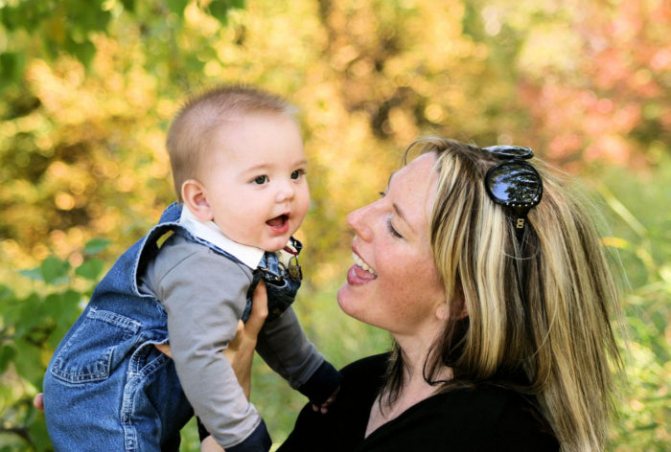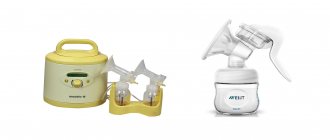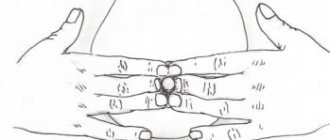Signs of readiness
To prevent tantrums, you need to properly wean your child off breastfeeding. The baby's readiness is the first thing you need to pay attention to.
Physiologically and psychologically, a child of 1 year and even one and a half is not ready for weaning. Readiness occurs at the age of 2 years and later. In our society, it is common to force the process of weaning. And mom needs to weigh the pros and cons before making such a decision. If the mother does not have serious medical reasons to stop breastfeeding, then it is better to continue feeding.
If the baby is completely ready to give up his mother's breast, a natural cessation of feeding will occur. The baby will simply stop latching and at one point forget about milk, but only a few voluntarily give up breastfeeding at 1 year of age. More often, lactation ends on the initiative of the mother.
Signs your baby is ready to wean:
- the diet consists of adult food, and milk is a treat;
- the baby has baby teeth and can chew food;
- the sucking reflex is weakly expressed (usually it begins to fade at 1.5-2 years and disappears by 3 years);
- the baby calmly falls asleep without his mother’s breast;
- calms down without applying.
If another tooth begins to emerge during weaning, it is recommended to continue breastfeeding. You cannot curtail lactation while the baby is ill, while traveling or when moving. In order for this process to take place with less stress for a yearling, you need to choose a stable and calm period.
Breast-feeding
So, 2 g 11 months, without a month, three years of breastfeeding. My daughter forgot about breasts! No, not so much severe amnesia, but classically - less, less, less, and one fine day I simply didn’t remember that I should check in at the feeder. I'll start from the end. We haven't fed for a week, almost a week and a half. The daughter behaves normally, doesn’t put her fingers in her mouth, doesn’t require more attention than usual, sleeps as usual, doesn’t react to naked breasts or reacts in the style of “Are you looking for a bra? there he is!” My breasts are not filling, however, this has been the case for a year now; pumping, as you might guess, is not required. We sleep together, but, again, I can sleep in whatever I usually wear, that is, nothing - T-shirts, turtlenecks, spacesuits are not required so that the little one doesn’t see my breasts. I'm happy . And now - in telegraph style, if anyone needs details - ask, otherwise I can talk for a long time))). The GW turned out to be almost problem-free. Up to 7 months - only breasts. After 7 months - complementary feeding + breastfeeding, but breastfeeding for a long time amounted to about 90 percent of our diet. From the age of 1, complementary feeding from pampering gradually became food, and only then did the feeding regime begin to noticeably change, and until that time they fed around dreams, during the day - on demand, and 3-4 times at night. By the age of one and a half years, there were two daytime naps left, so that, in combination with night sleep, they amounted to 6 obligatory full feedings + 2-3 frivolous feedings at night. During the day, in the interval from 1.5 to 2 years, they breastfed very irregularly, which is associated with a significantly changed walking style: while the daughter did not walk or walked poorly/little, she spent a lot of time in her arms, but then why not suckle? ))) Autonomous walks contributed to the fact that it was more interesting to play than to eat anything, and if you want to have a snack, then preferably quickly, so that you can return to the slide/swing/sandbox again - and here drinking yoghurts are our everything . Again, because of the summer, I wanted to drink more than to eat, and mastering the art of drinking from a bottle - that is, from the neck - became an important skill: in terms of quickly quenching thirst, the chest clearly loses to the bottle, because the bottle can be pulled out anywhere, unlike) ). So it turned out that between dreams we mostly walked, after the walks we quickly ate something or didn’t eat, went to bed, our daughter received the breast and fell asleep, woke up, suckled, ate or didn’t eat, and we went for a walk again. But there was also bad weather and poor health - and then the chest worked to its fullest, because nothing distracted from it. About two years ago, something important happened: night feedings went away. Sami. Well, almost on their own. It’s just that one day my daughter, waking up, said not “Sisyu”, but “Hug me” and immediately fell asleep. I said "Yeah!" and in the future, about her night awakenings, the first thing she asked was “Hug? Some water? To the toilet? — and we never returned to nightly sucking. I don’t rule out that this is also due to the full set of teeth, which have stopped bothering my baby. During the same period, one daytime nap was finally established, i.e., the number of obligatory feedings was reduced to four, and without night feedings. Just before two years of age, the comfort feedings finally went away. At 2.5 years old there was the last case of daytime feedings outside of dreams, almost a relapse - due to ARVI, which overwhelmed our entire family. The disgusting thing my dad brought left me with neither the strength nor the desire to cook anything, but my child only wanted to be closer to me and “sucked in” all her troubles, as they say, the breast was food, and drink, and affection, and communication - just infancy in its purest form. But after recovery, there was a qualitative leap, for both of us: my daughter lost her waking up feedings, including the early morning ones, and my hormonal levels clearly changed - my appetite and taste preferences returned to pre-pregnancy levels, and my weight began to slowly but go away , the breasts decreased by about one and a half sizes within a month or two. Apparently this was the beginning of the end))). September, 2 years 8 months - the daughter periodically begins to “forget” to suckle during the daytime nap. October - the sucking mode is the same, but sucks without feeling, for 2-3 minutes, in the “hello boobs - goodbye boobs” mode and, most importantly, the breast clearly ceases to be a necessary condition for falling asleep. That is, its presence was welcomed and even required, but my daughter fell asleep after sucking, quite after, 20-30-40 minutes later, having talked, hugged, read and sang, i.e., there was no strong breast-sleep connection, GV became one of the many episodes before bed, not the most important, although very favorite. November - I began to fall asleep during the day without breastfeeding, I, to be honest, somehow didn’t even notice how exactly this happened, I just suddenly realized: yes, she didn’t kiss... and yesterday.. and like the day before yesterday The first half of December - at first After a time, my daughter began to forget about her breasts: she goes through the entire bedtime program - dinner, toilet, book, song, hugs, water, toilet, hugs - oops! sleeping! On the trail. he still remembers the day about his breasts, then forgets again, and now he doesn’t remember the dates from December 10-12. Let me note again: I don’t hide my breasts, I don’t distract, I just don’t suggest, supporting the trend, but the daughter makes the choice herself. And judging by the fact that she began to say “ggud” and not “sisya”, this choice has already been made.
Why am I scribbling all this out? I know for sure that each mother-child pair is individual, there are no identical relationships and there are no identical scenarios for breastfeeding. It is quite obvious that for others the breastfeeding itself and its completion may take a completely different path. I know. BUT! I am so much
I read about the difficulties of completing breastfeeding after a year, about the psychological problems of mothers, about their mothers’ dependence on breastfeeding, which, honestly, I continued to feed only and exclusively out of laziness - I’m too lazy to organize anything in life, including weaning . And now my personal experience (yes, this is not statistics, but it is a fact) brought me the following thoughts: all the talk about dependence on breastfeeding, about the difficulties of weaning, about the fact that mom will have to learn for a long time how to express her love and affection in some other way and so on. - all these brilliant ideas, IMHO, are based on the experience of EARLY weaning, when, in fact, in most cases the child is not ready to leave the breast, when the mother’s hormones prevent her from tearing the child away, when in fact you need to learn to maintain a connection with the child and develop ways to show tenderness simply due to the child’s age and development, and the process of weaning itself must be organized, arranged and sustained. But for some reason, the wise theorists do not take into account the fact that by the age of 2-3 the child has already received everything he deserves and he simply DOESN’T NEED more, that he and his mother long ago developed a wagon and a small cart of methods of communication and a chest in their communication - where - it is far in the background that a mother’s “dependence” on breastfeeding is not a dependence at all, but a need for a healthy nursing body, which will go away normally, just as the child’s need to suck goes away. Now I’m listening to myself - is there depression there? feelings of loss? desire to take back control? No! I, like my breasts, practically did not notice what had happened, I simply noted a little line for myself: my baby has become a little more mature. So, dear mothers, if any of you in long-term breastfeeding are afraid mainly by the difficulty of weaning a grown-up child at a conscious age - do not be afraid; you might be afraid of anything else, but you don’t need to do this, they’ll get pumped up and fall off on their own, like leeches
source https://forum.materinstvo.ru/index.php?view=findpost&showtopic=736254&p=1…
Komarovsky about feeding after a year
According to the famous doctor Komarovsky, breastfeeding after a year can continue solely at the request of the mother. In this, his position differs from the opinion of breastfeeding consultants who welcome long-term breastfeeding.
According to Komarovsky, weaning before a year is definitely harmful. If a woman feeds until 12 months, then she has fulfilled her duty. What to do next depends on the specific circumstances in the family. If the mother likes to feed and there are no serious life obstacles to this, then we can continue. Long-term breastfeeding does not harm either the mother or the child. If a woman decides to wean her one-year-old, then this will not fundamentally affect his health or psyche.
A soft way to complete a GW
Gradually ending breastfeeding is the best way for a woman and her baby. The number of applications decreases during the day and then at night. Canceled feedings are replaced with adult food or an adapted formula. With a gentle weaning method, children feel comfortable and do not experience stress. Approximate scheme for discontinuing breastfeeding:
- First, the mother replaces one daily feeding with adult food or formula, after 2-3 days or a week, when the child is used to it, cancels the second, and so on.
- Then you should teach your child to wake up without a breast.
- Night feeding is cancelled.
- Mom stops breastfeeding at night.
All these steps may take several weeks or months. When deciding to wean a one-year-old, the mother needs to choose whether to switch him to formula or completely eliminate milk from the diet. Your pediatrician will give you individual recommendations.
Refusal to breastfeed at the age of 1-1.5 years is difficult. Mom needs to be patient and persistently pursue her goal. It is important not to be strict, as the baby will experience physical and emotional discomfort.
When weaning from breastfeeding after one year, you need to have more frequent contact with the baby. Lactation maintains the emotional and physical connection between baby and mother.
When weaning, it must be replaced with something. Breastfeeding experts advise hugging your baby more often, giving him massages, and holding him in your arms. In this case, the yearling will not feel abandoned. When a mother stops breastfeeding but does not compensate for the lack of physical contact and attention, children have a hard time with weaning.
If, against the background of the abolition of daytime applications, nighttime applications become frequent, then you need to take a step back. It will not be possible to curtail lactation in 2 days. It is necessary to replace feedings gradually so that this does not affect the baby’s well-being. Positive dynamics will be noticeable within a week. If this does not happen, perhaps you were in a hurry.

The most difficult thing is to give up evening and night applications. Breastfeeding before bed should be replaced with a new ritual. An alternative is reading books, massage, rocking in a crib, lullaby. If you previously practiced co-sleeping, you should give it up. Being next to the mother during the night's rest, the baby involuntarily asks to suckle. If a woman is not ready to give up sleeping together at this moment, she will have to wear closed pajamas so that the baby does not have free access to the breast.
“Mom, I’m already an adult!”
At the age of one and a half years, most children are already ready to do without their mother’s breast. However, everything is individual. The baby himself will tell you when the moment of most painless weaning comes.
For example, a baby begins to show interest in eating independently: he copies adults, snatches the spoon from your hands, trying to eat on his own, drinks from a cup himself, and so on. Or the baby tries to feed dolls and animals, is ready to share toys, experiencing the joy of the process of giving.
Of course, such actions by the baby do not mean at all that it is time to immediately stop breastfeeding. But it’s still worth starting preparations for gradual weaning.
Abrupt weaning
When unforeseen circumstances arise, women are interested in how to wean a child from breastfeeding in a short time. This is often necessary if the mother is seriously ill or if she needs to leave for a long time.
During abrupt weaning, the child behaves restlessly. To make up for the lack of physical contact, you need to take him in your arms, hug him more often and talk about how much mom loves. To maintain a psycho-emotional relationship, it is recommended to spend more time together, play active games, and take walks. This will help the one-year-old not to think about his mother’s milk and not feel disadvantaged.
Breastfeeding specialists and modern pediatricians do not recommend abruptly weaning a baby unless there is an urgent need.
Food and sleep
Often mothers want to wean their baby from the breast because of his poor appetite.
. Sometimes it just seems to them that the child eats little other food and prefers breast milk to everything, sometimes this is actually the case. In a natural situation, if the child gradually switches to the common table, and the mother tries not to feed him other food, but to maintain the baby’s interest in it, there will be no bad appetite in the second year of life. If a child is weaned from the breast in order to force him to eat another food, there may be two scenarios: either the baby will eat another food, or he will end up with a little one, who will be very problematic to feed.
Mothers and their relatives worry about the need to sleep with the baby and put him to the breast at night.
In our society, co-sleeping is still considered a bad habit that needs to be eradicated. But a child until about the age of three (regardless of the type of feeding) has a need to sleep together with his mother. And this need goes away with age, just like the need for breastfeeding.
If a mother, since the birth of her baby, has managed to organize a comfortable nighttime co-sleep, has learned to sleep with the baby and relax at the same time, night feedings of a child older than one year do not cause her any inconvenience.
If the mother goes to work, then night feedings become more frequent and longer for a while. The baby compensates for the missing communication with the mother, receives the necessary tactile stimulation, albeit in a way that is not very clear to modern mothers, but quite natural in such a situation. In the same way, the intensity of night feedings increases if the mother begins to limit the baby’s need for daytime feedings when he is not ready for such a restriction.
And finally, about concerns about the decline in milk quality. The mother’s body does not know that today the baby turns one year old, and from that moment on it cannot begin to produce second-grade milk. In the second year of lactation, milk continues to contain proteins, carbohydrates, lipids, essential vitamins, microelements, biologically active substances and much more that are optimal for the baby to digest. When a woman experiences lactation involution, her milk becomes similar in composition to colostrum and contains more immune defense factors than mature milk. If weaning occurs in a timely manner, it always coincides with the involution of lactation in the mother.
Separation method
Weaning a baby through separation is also not the best way to end lactation. Mom is the closest and dearest person. When a one-year-old is in pain or scared, he finds comfort in his mother’s arms.
Weaning from breastfeeding is accompanied by a change in the physical and emotional state of a one-year-old child. During this period, the baby needs his mother more than ever. If the baby's breast is taken away, he can still cope with this problem. When the mother disappears at the same time, the baby experiences serious stress.
Modern pediatricians do not advise women to use this method, despite the propaganda of Soviet doctors. When the mother is nearby, the baby tolerates the cessation of breastfeeding much easier.

Not ready for weaning
In traditional cultures, weaning a child is not directly related to his calendar age. One year is a period that often appears in pediatric science; in addition, by this age, children, as a rule, begin to walk independently and cease to be associated with babies.
What complicates matters is that most young women today have never seen how a child over a year old behaves while still suckling at his mother’s breast. They perceive the normal, genetically determined, physiologically and psychologically based behavior of a child as something incredible that needs to be put an end to as soon as possible. Unfortunately, relatives, friends, doctors and even many child psychologists, who have also never seen a breastfeeding “runner”, cannot provide the mother with the necessary support.
What does breastfeeding a baby older than one year look like? What behavior can be considered natural and correct?
For example, like this.
The baby is applied to the breast in order to fall asleep (at night or during the day) and is applied when waking up - in the morning and after a nap. The baby suckles several times at night, mainly in the early morning hours until he wakes up. During the day, he can drink his breakfast, lunch and dinner from his mother's breast. The baby attaches to the breast when he needs comfort for any reason (hurt, scared, tired). He can take a sip if he's thirsty. The first thing the baby does is attach itself to the mother's breast if the mother enters the house after a long absence. He often latches on when he is bored and has nothing to do, or when his mother takes a stationary position, for example, sitting down to talk on the phone. If the baby has the need to kiss, it can be difficult to distract him from this idea.
A baby who behaves this way is not ready for weaning. Most children aged 1 to 2.5-3 years behave this way.
How to stop lactation
Gentle weaning allows you to stop lactation painlessly not only for the baby, but also for the mother. Breast milk is produced as needed. The less it is in demand, the less it comes. With the gradual abolition of day and night feedings, a woman's milk volume naturally decreases. Involution occurs a few days or weeks after the last application. The duration depends on how great the need for the breast was before weaning.
After discontinuation of breastfeeding, milk flows will not disappear immediately. It is necessary to ensure that the chest does not overfill. If there is a lot of milk, you need to express it. It is important not to empty the breasts, but to get rid of the excess until relief occurs. When expressing, you should not use a breast pump, as it will provoke relactation.
There is an opinion that you can suppress lactation with the help of sage. The decoction stimulates the growth of estrogen and suppresses milk production. To alleviate the condition of engorgement of the mammary glands, you can make a compress from fresh cabbage leaves.
How to tighten your chest correctly?
Breast tightening to stop lactation is a traumatic procedure. And if it is not carried out according to the rules, mastopathy may develop in the future.
So, the breasts are tightened after feeding using a wide sheet (usually the husband or other relatives of the nursing mother do this). It is necessary to tighten it firmly enough, but not to the point of pain. The bandage is applied so that the mammary glands are completely covered from the armpits to the lower ribs, the knot is tied on the back. The bandage is left on for only a few hours a day and then removed. This procedure can be repeated for 7–10 days. If you feel a pronounced heaviness in your chest, you can remove the bandage and feed the baby. Or you can express a little milk from your breasts, but not all of it, so as not to stimulate further production. Then you need to re-tighten the breasts for several hours. Remember: you cannot keep the bandage on for days.
Tips for moms
Girlfriends, mothers, and grandmothers can advise on traditional weaning methods. GW consultants consider them ineffective and dangerous. Do not bandage the breasts as this will cause injury to the mammary gland. You should not smear mustard and garlic on your nipples to cause disgust in your baby. Dr. Komarovsky calls such manipulations barbaric.

Recommendations for women:
- Weigh the pros and cons before stopping breastfeeding after a year. WHO recommends breastfeeding children until 2 years of age and beyond.
- Be flexible. If you feel that your child is really having a hard time, you should take a step back or abandon your idea for a while.
- During weaning, spend more time with your child. Be in public places more often so that the one-year-old does not have the desire to latch on to the breast.
- It is necessary to keep yourself busy so as not to sit idle. The mother, who lies down to rest, involuntarily stimulates the baby’s desire to attach to the breast.
- Before bedtime, feed with nourishing, but easily digestible food. This will help delay night feeding.
- Create a new ritual. Previously, the child fell asleep at the breast. Now we need to develop new habits and associations for him.
- Wear closed clothing and do not change clothes in front of the baby. If the mother wears clothes with a deep neckline, the child will remember the breasts.
- Choose a place in the house, for example, an armchair. Breastfeed during weaning only in this place, so that the baby does not have the desire to suckle under other circumstances.
The weaning process after a year takes from 2 weeks to several months. Each child reacts to change differently. While some children easily accept deprivation, others find it difficult to tolerate the lack of mother’s milk.
What about mom?
Mothers often complain that they are “attached” to their baby.
and they can’t leave him with someone, since
his mother’s breast is needed quite often
. But a child over one year old will not demand breasts from grandma, dad, or nanny. In the absence of the mother, the baby gets used to behaving differently. He is quite capable, for example, of comforting himself by climbing into the lap of an adult. He eats great at lunch without needing his mother's milk. He falls asleep in his mother's absence if another person puts him to sleep.
Mothers do not like that the child may require the breast in a place not suitable for feeding
: in a store, clinic, on the street, in a restaurant, visiting. But the child simply seeks comfort from the breast if he begins to experience discomfort. For example, if a mother and baby go to the store at the end of a walk, when he is already tired, and then he still has to wait for something, endure the presence of a large number of strangers, sometimes it is noisy and stuffy... How can one not look for solace in a familiar place, when one’s own Is your strength already running out? In such a situation, the mother can only be asked to leave the store as quickly as possible and arrange a visit next time so that the child is not tired (if it is not possible to get to the store without him).
In the clinic, the baby is usually either bored when he has to wait a long time, or scared and in pain. In my opinion, the opinion of a lactation consultant, and the mother who fed the “runner”, there is nothing wrong with the fact that the child suckles a little while sitting in line, in the corridor, if he has already read all the books, played with all the cars, ate an apple , but the wait is still long. And if blood was taken from his finger, and consolation is needed immediately, giving the breast to a crying child is a completely natural action.
On the street, the baby needs to be held if he is seriously injured and in pain. More often this happens in the summer, when the baby runs around with bare knees and is minimally dressed. In such a situation, the child may have to be attached. Sometimes the baby needs to be latched on the street if the walk is long and he is tired. You'll have to make an effort - and next time it's better to plan a walk.
You can assume in advance that in a restaurant or at a party the need to suck will most likely arise - and dress accordingly, choose a suitable place. In general, breastfeeding in public can always be arranged or avoided.
Mothers are embarrassed by the need to “be naked” in the presence of strangers. But you don't need to undress to feed your baby. All mothers who have breastfed for a long time are able to do this almost unnoticed by others. Try to find such a mother among your surroundings and learn from her.










